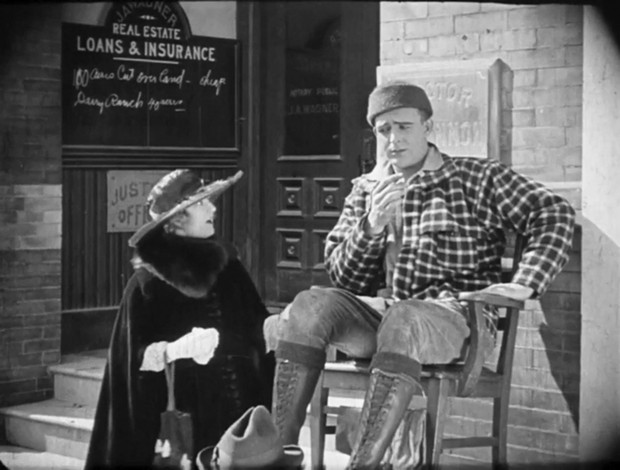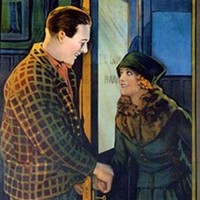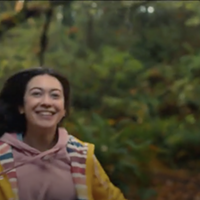[
{
"name": "Top Stories Video Pair",
"insertPoint": "7",
"component": "17087298",
"parentWrapperClass": "fdn-ads-inline-content-block",
"requiredCountToDisplay": "1"
}
]
For nearly all of that century, the 1919 made-in-Humboldt movie The Valley of the Giants was thought lost. In 2010, one surviving print surfaced in an archive in Russia. Film historian Edward Lorusso of Maine started a crowd-funding campaign to translate the silent movie's Russian inter-titles (dialogue and narrative in a silent film) into English to release it on DVD. On Nov. 3 and 4, Humboldters will have a chance to see it at the historic Eureka Theater (612 F St.) with a live musical score and sound effects by Squeezebug. The showing benefits the architectural preservation organization the Eureka Heritage Society, which brings us the annual Eureka Home Tour and owns and maintain Eureka's Annie B. Ryan House and Gardens.
Based on a novel by Bay Area author Peter B. Kyne, The Valley of the Giants intersects with Humboldt history. In 1898, 18-year-old Kyne lied about his age to get into the Spanish-American War. Returning from the Army, he trained as a stenographer and landed a job in the San Francisco office of Eureka's Dolbeer-Carson Lumber Co., working for timber barons John Dolbeer and William Carson. In 1917, Kyne, by then a best-selling novelist, traveled to Eureka to research his next book, a melodramatic "romance of the redwoods." Legend has it he wrote the last 30,000 words of the book in one day. He had a contract for the novel and wanted to deliver it to his publisher before enlisting for World War I.
The Valley of the Giants was published just in time for Christmas in 1918. By January, Paramount was planning to film the movie on the very locations where the novel was set.
The setting "Sequoia" is a lightly fictionalized Eureka and the novel's timber baron John Cardigan bears a strong resemblance Carson. Cardigan vows to preserve a grove of virgin redwoods, while the real life Carson pledged his support for the creation of a redwood park on timberland he owned near Fortuna. Possibly due to his 1912 death, this plan eventually failed and "Carson Woods" was logged in the early 1920s — widely cited as the shock that spurred many save-the-redwoods supporters into action.
In January of 1919, Humboldt newspapers reported director James Cruze, his cast and crew would arrive in Eureka the next month. Leading the cast was superstar Wallace Reid, the top-earning movie star in the country. Filming took place in Eureka, Samoa, Arcata, Trinidad, Korbel and Scotia. Eureka's celebrated Carson Mansion plays the role of the Cardigan Mansion.
Real life got too close to fiction for the film's cast and crew on Feb. 23, 1919. En route to filming a thrilling train wreck sequence in the woods near Korbel, the Hammond Lumber Co. caboose in which they rode derailed. The Humboldt Times reported on Feb. 25, "if the train had been going at 40 miles an hour instead of four when the caboose jumped the track in the Hammond woods near Camp 22 Sunday afternoon there might have been a real accident." The Times cheerfully continued, "As a matter of fact, however, the near-wreck in the woods Sunday was just an interesting experience for the members of the company."
The "near-wreck" proved all-too-real for star Wallace Reid. He sustained a scalp wound several inches long and was prescribed morphine so he could carry on with filming. This would lead to addiction that contributed to his death in January of 1923, at 31, after a highly publicized attempt at rehab and to the shock of his adoring public. He was the first American celebrity known to have died as a result of drug addiction.
That tragic fate was undreamed-of in March of 1919, when Reid and his fellow actors made special appearances at the Minor Theatre and Eureka's Rialto Theater at showings of two of his earlier films. Six months later, the Rialto hosted the almost-world-premiere of The Valley of the Giants at the Rialto on Sept. 4, a week after it opened in New York City. Faint traces of the one-time 1,200-seat movie palace at 525 F St., a block away from the Eureka Theater, can still be seen; local historian Tom E. Murray wrote in 1992, "Though gutted, the shell of the building still stands ... housing a Chinese restaurant.") The Humboldt Times described Valley of the Giants as "a picture everyone will want to see." Tickets for the 1919 Eureka premiere cost 30 cents for adults and 20 cents for children; "loge chairs" cost 50 cents — all prices included the war tax. On Sept. 4, the Times enthused:
... all of us Humboldters remember our first inside view of the making of motion pictures while Reid's company was busily making "local color" scenes in various parts of the county. When they staged the big fight scene on Eureka's waterfront it seemed that half the population was on hand to see how it was done. And now the great picture is finished and we who saw it made are to have the first opportunity of seeing it. Those of us who have promised to do their best to save the redwoods for a national park, and this means all of us, will take this picture to heart ... And as the picture travels on its way around the world it will show countless millions the beauty of our redwoods and thus help to convince outsiders that the giants of the forest should be preserved for all time.
Kyne's melodrama played longstanding roles in both the save-the-redwoods movement and Humboldt history. In August of 1919, in a contest sponsored by the Humboldt Standard, the Kyne-inspired name "Highway of the Giants" was chosen for the stretch of the new Redwood Highway now known as Avenue of the Giants. Kyne himself is credited as the person who came up with the name for the Six Rivers National Forest and in 1949 he was guest of honor at Eureka's first-annual "Valley of the Giants Jubilee" on the Fourth of July. After Kyne's 1957 death, Eureka's Lion's Club chapter dedicated a plaque in his memory at Sequoia Park, featuring a quote from The Valley of the Giants: "I'm not going to going to cut the timber in this valley. I haven't the heart to destroy God's most wonderful handiwork."
Tickets for the Nov. 3 and 4 showings at 7:30 p.m. at the Eureka Theater are $20 via eventbrite.com, eurekaheritage.com or at the door. "
Alex Service (she/her) is the curator at the Fortuna Depot Museum.
Speaking of...
Comments (3)
Showing 1-3 of 3
more from the author
-
Not Expelled But Not Fully Welcome
Japanese experiences in Humboldt's Chinese exclusion era, from education to terrorism
- Aug 24, 2023
-
Chinese Again in Humboldt, Part Four
An interview with Lee Eeso of Astoria
- Jun 1, 2023
-
Chinese Again in Humboldt, Part Three
Even at the cost of bloodshed
- May 25, 2023
- More »



































